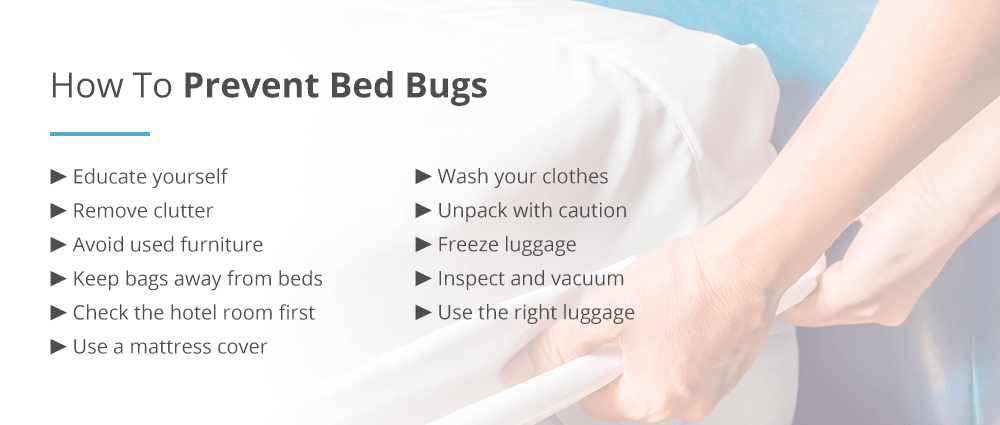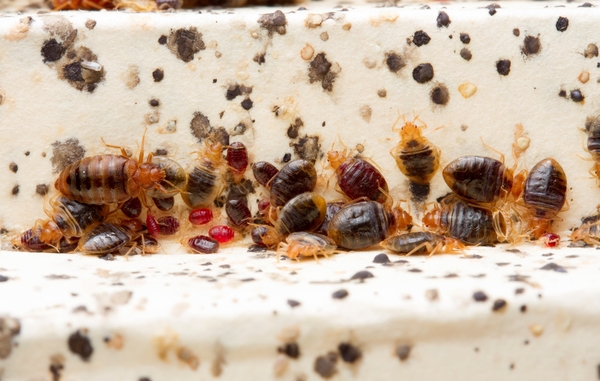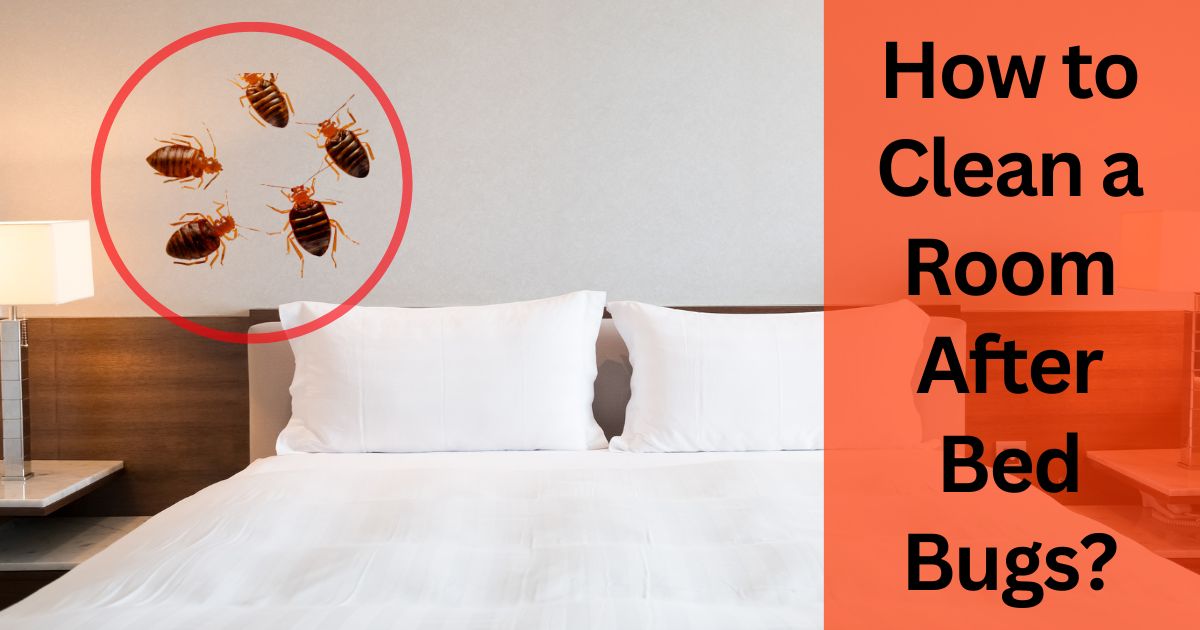Clean a room after bed bugs by first removing and laundering all bedding and curtains at high temperatures. Next, scrub surfaces to dislodge eggs and use a vacuum to remove bugs and debris from cracks and crevices.
Dealing with a bed bug infestation requires a thorough and strategic approach to ensure these pests are completely eradicated from your living space. The cleanliness of a room plays a pivotal role in both preventing and combating bed bug problems.
An infestation not only causes discomfort but also poses a risk of spreading throughout your home if not addressed promptly. Cleaning a room post-bed bug infestation involves not just superficial tidying but also deep cleaning and sometimes even chemical treatments to eliminate any lingering bugs and eggs. Homeowners and renters alike need to be vigilant, employing a combination of heat, cleaning agents, and vacuuming to tackle affected areas effectively. Proper disposal of infested items is crucial, and in severe cases, professional extermination might be necessary. Keeping a room free of clutter can significantly hinder bed bugs’ ability to hide and breed, making future outbreaks less likely.
Recognizing Bed Bug Infestation
Understanding the early signs of bed bug infestation saves time, money, and stress.
Signs Of Bed Bugs
Spotting these pests requires a keen eye. Key indicators include:
- Reddish or rust-colored stains on sheets or mattresses from crushed bugs.
- Tiny, dark spots, which could be bed bug excrement, on bed linens.
- Small, pale-yellow skins that nymphs shed as they grow larger.
- Live bed bugs ranging in size from the head of a pin to apple seeds.
Health Implications
Bed bugs are more than an annoyance.
| Health Impact | Description |
|---|---|
| Skin Reactions | Itchy welts or rashes from bites. |
| Allergic Responses | Severe itching, hives, or even anaphylaxis in rare cases. |
| Sleep Disruption | Insomnia or anxiety about being bitten. |
| Secondary Infections | Scratching bites can lead to infections like impetigo. |
Bed bug infestations require attention.
Seek immediate action to eliminate these pests and their health risks.
Immediate Actions Post-discovery
Imagine waking up to find bed bugs in your sanctuary, the bedroom. Quick and effective actions are crucial. Let’s explore the immediate steps to regain control and ensure a bug-free room.
Isolate Infected Items
Act fast to contain the infestation. Gather all bed linens, curtains, and clothing. Place them in sealed plastic bags. This step stops bugs from moving to other areas.
Avoiding Spread
Keep bed bugs from spreading with these tips:
- Seal cracks in walls and floors.
- Use vacuum cleaners with immediate disposal of bags.
- Do not move items from the affected room to others.
Dispose of the vacuum bag in a tightly sealed bag and trash it outside your home.
Selecting The Right Cleaning Strategy
After discovering bed bugs, choosing an effective cleaning strategy becomes paramount. Each method has its benefits. Your choice will depend on the severity of the infestation. Proper cleaning ensures the elimination of these pests and reduces the chance of them returning. Explore both chemical and natural ways to cleanse a room afflicted by bed bugs.
Chemical Treatments
Chemical solutions often provide a powerful punch against bed bugs.
- Use insecticides labeled for bed bugs. Check for Environmental Protection Agency (EPA) approval.
- Target cracks and crevices where bugs hide.
- After application, vacuum thoroughly.
- Consider a professional exterminator for severe cases.
Natural Remedies
Natural solutions are safer for households and pets. They can be quite effective.
- Steam clean surfaces at high temperatures. Bed bugs cannot withstand heat.
- Create a mixture of essential oils like lavender and peppermint. Spray around affected areas.
- Apply diatomaceous earth to the perimeter of rooms. It dehydrates the bugs.
- Encase mattresses and pillows in protective covers to trap any remaining bugs.

Credit: pestech.com
Prepping The Room For Cleaning
Discover the essential steps to prepare a room for a deep clean after a bed bug incident. Proper preparation is key to ensuring bed bugs have no place to hide and the eradication process is thorough. Here’s a guide to ready your room for cleaning.
Moving Furniture
Start by creating space. Remove furnishings from walls. Ensure every corner is accessible by creating a pathway for cleaning around the room. Follow these steps:
- Strip the bed of all linens.
- Keep furniture away from the walls.
- Empty drawers and closets.
Securing Electronics And Delicates
Electronics and sensitive items need protection from cleaning agents and methods. Wrap them in plastic or remove them from the room. Take these precautions:
- Unplug and cover all electronics with plastic sheeting.
- Place delicate items in a safe area.
- Use sealable bags for small electronics and jewelry.
Deep Cleaning The Affected Area
Winning the war against bed bugs calls for a thorough deep clean. This thorough strategy guarantees a bug-free haven. Take note of these key steps and prepare for an efficient cleanup.
Vacuuming Strategies
Vacuum every inch of the affected area. Bed bugs can hide in tiny spaces. Use a vacuum with a HEPA filter for the best results.
- Frequent vacuuming prevents bed bugs from settling in.
- Focus on mattresses, furniture, and curtains.
- Dispose of vacuum bags securely to avoid spreading bugs.
Steam Cleaning
Bed bugs despise heat. Steam cleaning offers a powerful solution. It reaches deep into fabrics, killing bed bugs instantly.
- Steam clean sofas, carpets, and bed frames.
- Move slowly, allowing the steam time to penetrate.
- Heat should reach at least 120°F to be effective.
| Area | Attention Level | Temperature |
|---|---|---|
| Bedding | High | 120+°F |
| Flooring | Medium | 120+°F |
| Upholstery | High | 120+°F |
Repeat steam cleaning for comprehensive coverage. Patience and persistence are key to eliminating these pests.

Credit: content.ces.ncsu.edu
Washing Fabrics And Linens
Washing Fabrics and Linens is a crucial step in the battle against bed bugs. These critters can cling to textiles, so proper cleaning is essential. From clothing to bedding, ensure every fabric within the affected area undergoes thorough treatment. Let’s explore the most effective methods for eradicating bed bugs from fabrics.
Temperature Settings
Hot water is best for killing bed bugs.
Use the highest heat setting your fabrics can handle. For most households, this would be around 120°F (49°C) or higher.
| Fabric Type | Minimum Temperature |
|---|---|
| Cotton | 120°F (49°C) |
| Linen | 120°F (49°C) |
| Synthetics | Check label |
Drying Techniques
Drying is just as important as washing.
- Use the dryer on the highest heat setting possible.
- Bed bugs die after 30 minutes in a dryer set to high heat.
- For items that cannot be tumble dried, use a hairdryer or garment steamer.
Items like stuffed animals and shoes may be placed in a mesh bag. Dry them on high for at least 30 minutes.
Bear in mind that high temperatures can damage some fabrics. Always check the care label.
Repairing And Sealing Entry Points
Repairing and sealing entry points is crucial after a bed bug infestation. These pesky pests can squeeze through the smallest of gaps. By sealing off their entryways, you ensure a bedbug-free zone. This not only helps in preventing future infestations but also improves your room’s insulation, making it energy-efficient.
Filling Cracks And Crevices
Bed bugs can hide in the tiniest places. Check for any cracks in the walls or flooring. Using a putty knife, fill these gaps with a sealant. Do the same for gaps around baseboards and moldings. Ensure all hiding spots are closed.
Window And Door Seals
Inspect your windows and doors. Worn-out seals offer bed bugs an easy entry. Replace any damaged weather-stripping. Use door sweeps for extra protection against bed bugs and other insects. This will also save energy by keeping the heat in during winter and the cool air during summer.
Remember:
- Examine all potential entry points
- Use appropriate sealants for different materials
- Regularly check and maintain seals
Ongoing Monitoring And Prevention
After a battle with bed bugs, your cleaning job isn’t done yet. Ongoing monitoring and prevention are essential. Bed bugs are crafty creatures. They require constant vigilance. Your mission is to keep them from returning. Stick to these proactive strategies to secure your space.
Setting Traps
Setting traps is a smart move to catch any straggling bed bugs. Use traps designed for bed bugs. Place them under your bed legs and furniture. This will intercept them as they crawl. Check traps regularly.
- Bed post interceptors
- Glue traps on room perimeter
- CO2 traps for active monitoring
Regular Inspections
Stay alert through regular inspections. Examine your mattress, bedding, and furniture often. Use a flashlight and a magnifying glass. Check for small, rusty spots. Look out for live bugs or shed skins. Inspections should be weekly.
| Area | What to Look For |
|---|---|
| Bed | Fecal spots, eggs, skins |
| Furniture | Live bugs in seams |
| Walls | Signs near electrical outlets |
Professional Help
Cleaning a room after bed bugs is tough. Facing an infestation demands swift action. Sometimes, DIY methods fall short. That’s where professional help shines. Experts bring powerful tools and knowledge to tackle these pests. Below, learn when to call in the troops and what to do once they’ve conquered the bed bug battle.
When To Call An Exterminator
Bed bugs are sneaky. They hide well and multiply quickly. Certain signs suggest you need a pro:
- Severe infestation: Spotting many bugs or their shed skins means trouble.
- Bites: Waking up with rows of bites could signal a bed bug problem.
- DIY doesn’t cut it: If over-the-counter sprays aren’t working, help is needed.
Post-extermination Room Restoration
After professionals treat your room, clean-up is vital. Follow these tips:
- Wash everything: Bedding, curtains, and clothes should hit the laundry, hot water cycle.
- Vacuum: Suck up any lingering pests from floors and furniture.
- Seal cracks: Close any gaps where bed bugs could enter or hide.
Ensuring a clean slate means you can sleep tight without the bed bugs biting again!
Maintaining A Bed Bug-free Environment
After tackling a bed bug infestation, keep those pesky insects away for good. A clean room is key to a bed bug-free life. Learn simple steps to ensure these critters do not return. A bed bug-free environment means peaceful sleep every night.
Educating Occupants
Knowledge is power in the fight against bed bugs. Share facts with everyone at home. This helps stop bed bugs from coming back. Here are key points:
- Identify bed bugs early.
- Know signs of infestation.
- Understand how they spread.
- Avoid bringing used furniture inside without checking.
- Keep personal items off common area floors.
Routine Cleaning Schedule
Regular cleaning prevents bed bugs. Stick to a schedule. Include these tasks:
| Task | Frequency |
|---|---|
| Vacuum carpets and furniture | Twice a week |
| Wash and heat-dry bed linens | Once a week |
| Declutter living spaces | Monthly |
| Inspect and clean secondhand items | Before bringing indoors |
Following these steps greatly reduces bed bug chances.
/handle-bed-bug-infestation-laundry-2146304-06-f15609fb1a824d7792eaa959e6b0cac5.jpg)
Credit: www.thespruce.com
Frequently Asked Questions For How To Clean A Room After Bed Bugs?
What Steps Are Involved In Cleaning After Bed Bugs?
The process involves thorough vacuuming, washing fabrics in hot water, steaming, and applying diatomaceous earth or bed bug sprays. Seal and dispose of the vacuum bag outside.
Can Bed Bugs Live After Cleaning?
Bed bugs can survive traditional cleaning. However, deep cleaning techniques like steam cleaning and insecticide application can effectively eliminate them. Regular monitoring and additional treatments may be necessary.
How Do I Disinfect My Room From Bed Bugs?
Disinfect by laundering bedding and curtains at high temperatures. Use a steamer for mattresses and furniture. Apply bed bug-specific pesticides, and seal cracks and crevices where they could hide.
What Cleaning Products Kill Bed Bugs?
Products containing pyrethrins, pyrethroids, desiccants like diatomaceous earth, and bed bug-specific sprays are effective. Always follow the manufacturer’s instructions for safe and effective use.
Conclusion
Tackling a bed bug infestation takes diligence. Remember, thorough cleaning and heat treatment are your best allies in this battle. Keep your space decluttered, and vacuum regularly to prevent future outbreaks. With these steps, you’ll reclaim your room and peace of mind.
Victory over bed bugs is within reach!
Related posts:

I’m MD Tanvir, and I bring years of expertise gained from working closely with pest control companies to the forefront. My journey in the industry has inspired me to launch Bug Battler, a platform aimed at equipping people with the know-how to combat pests autonomously. Through Bug Battler, I aim to empower individuals with practical insights to tackle pest infestations effectively.

